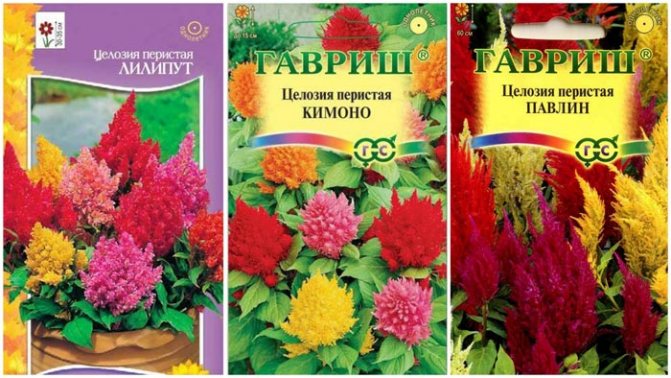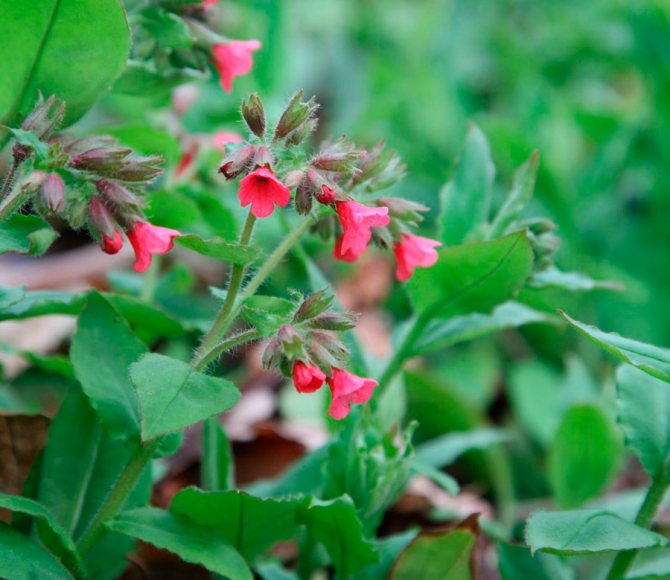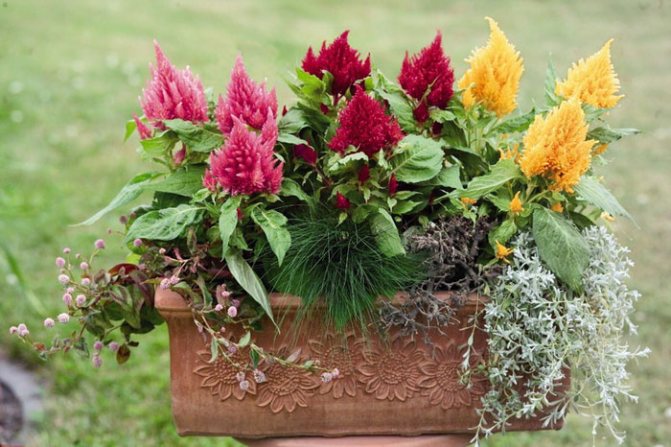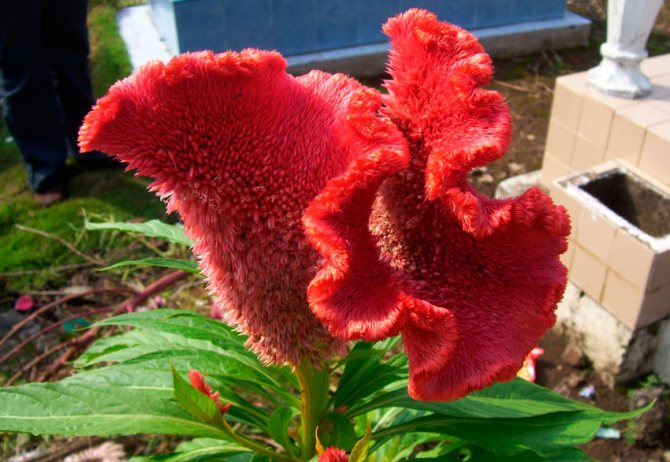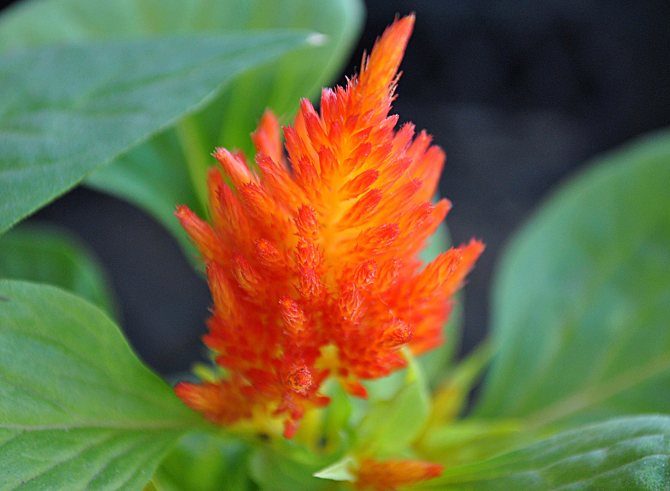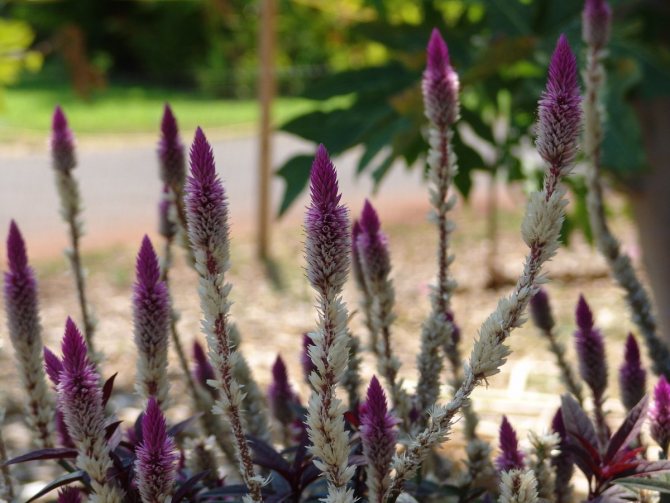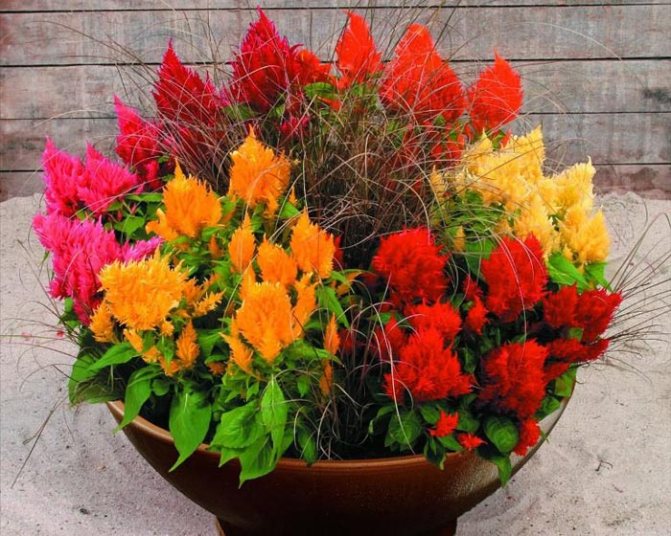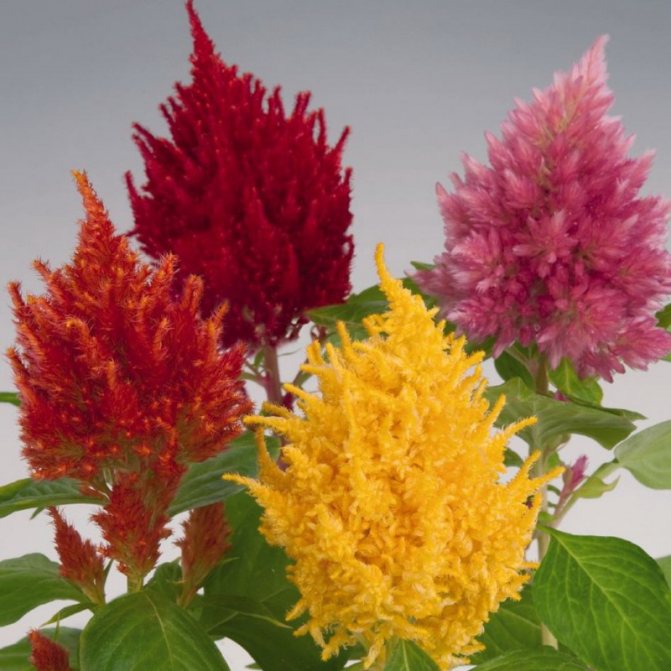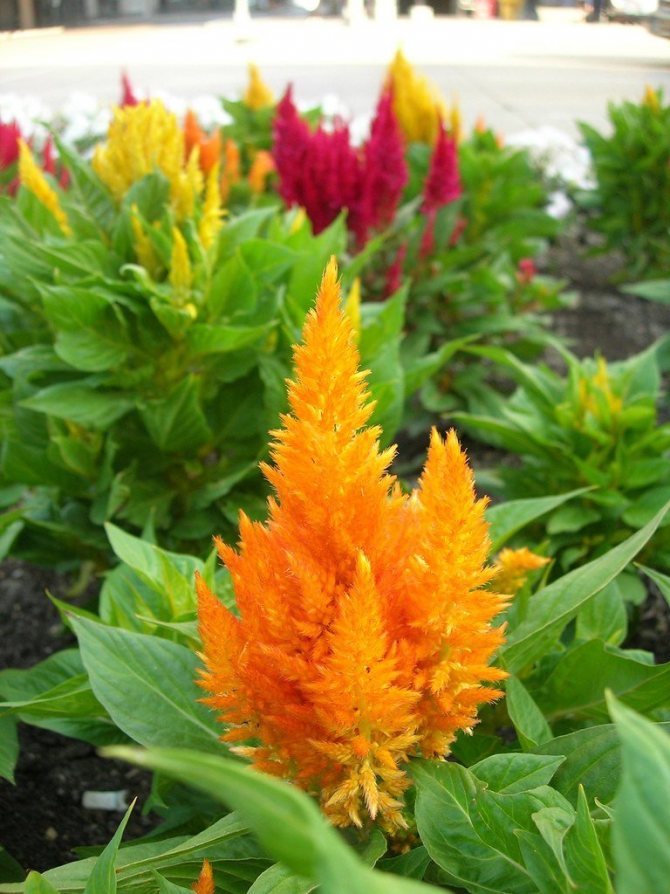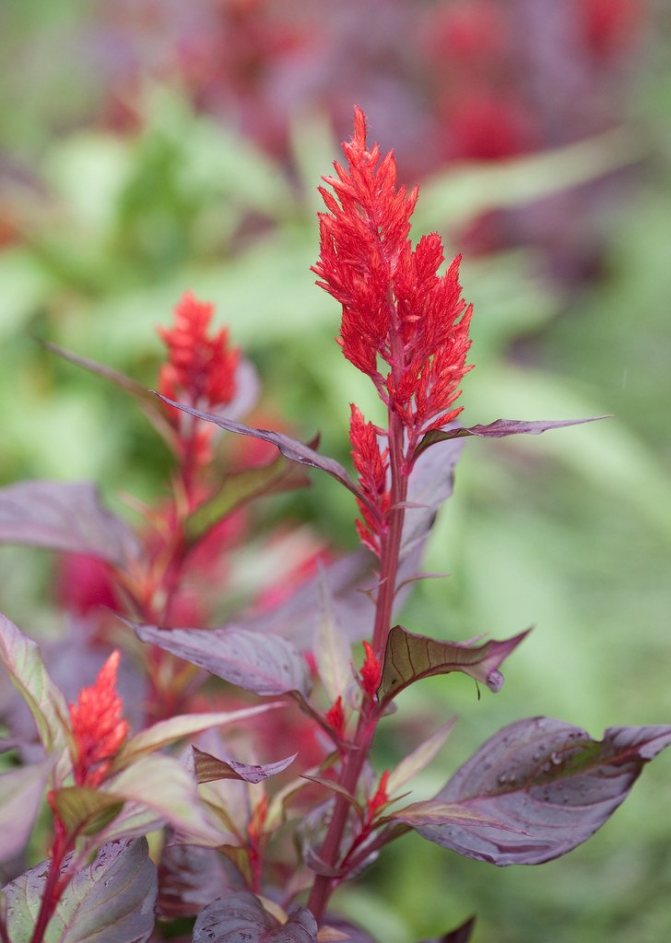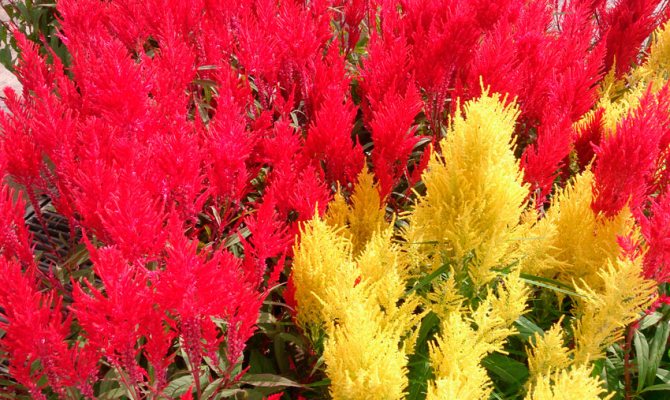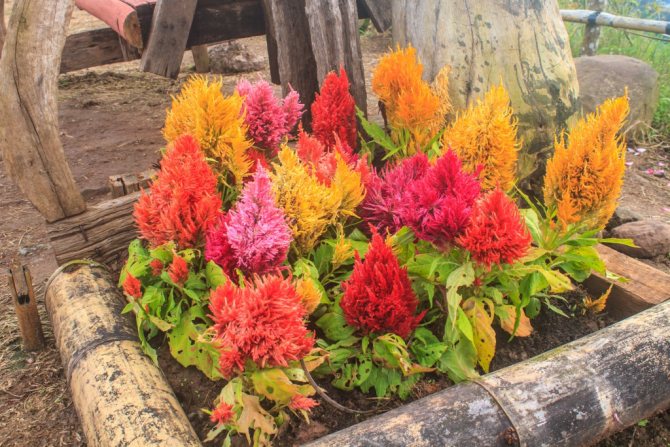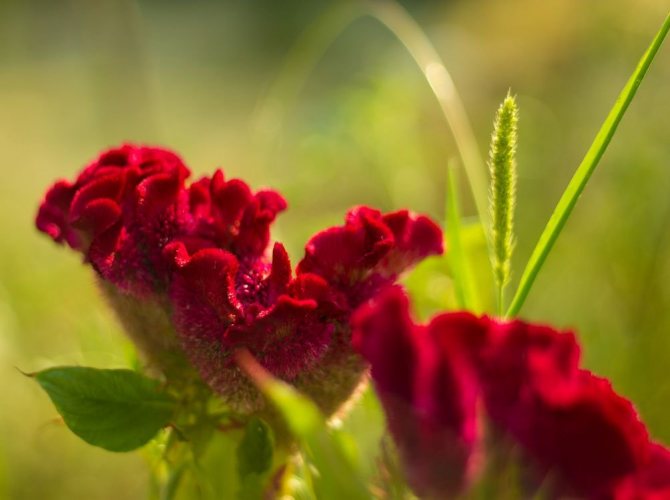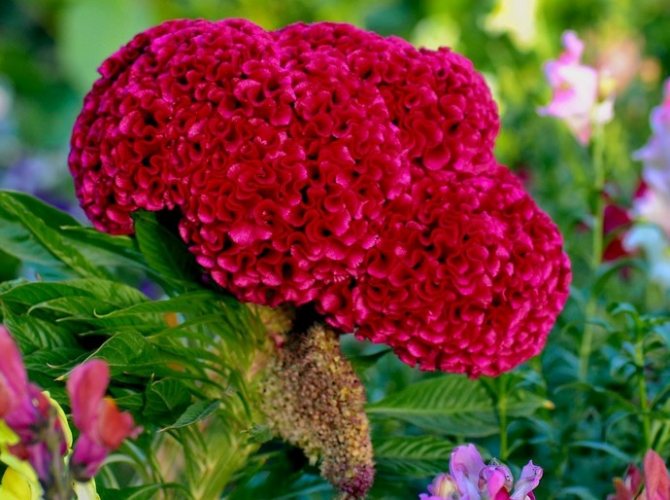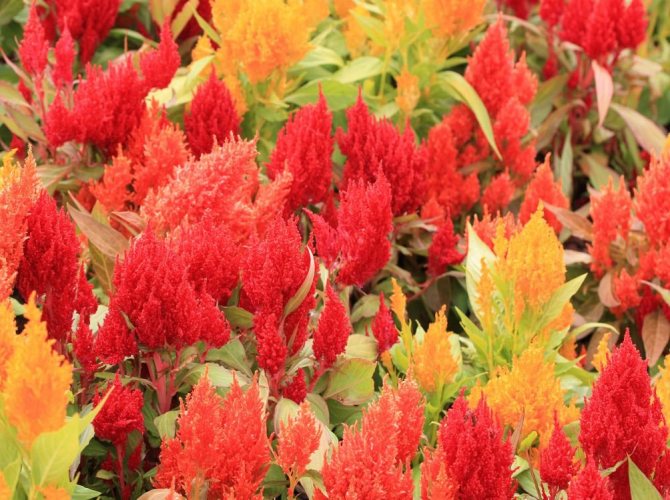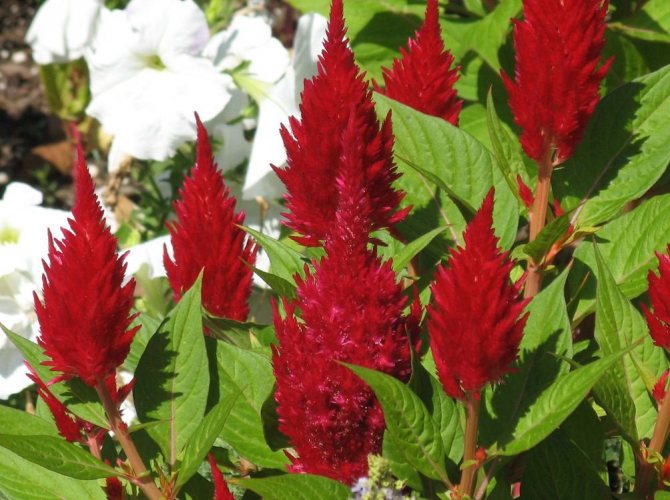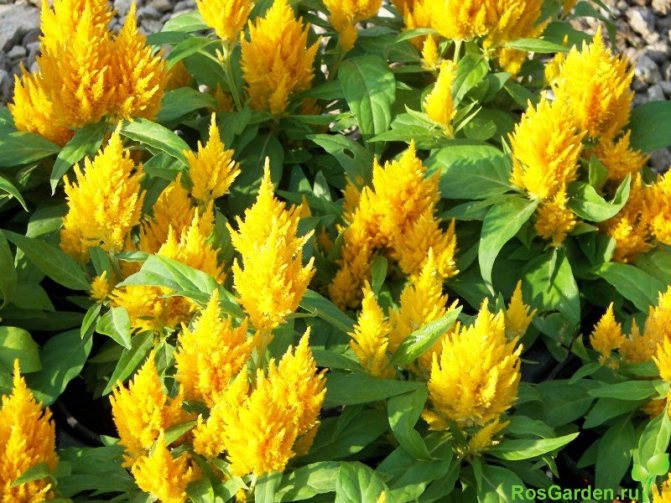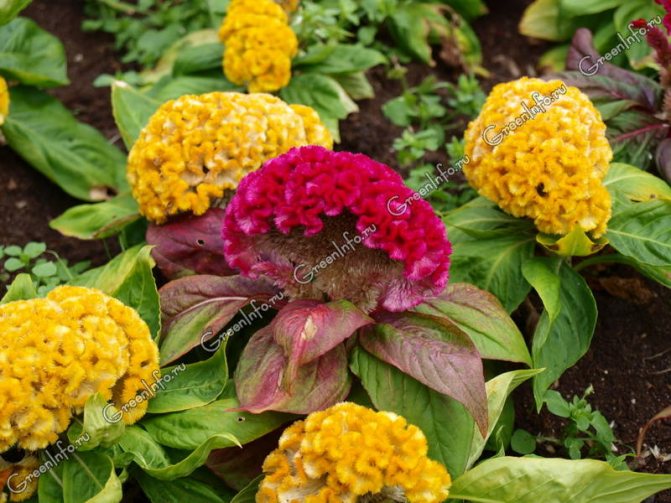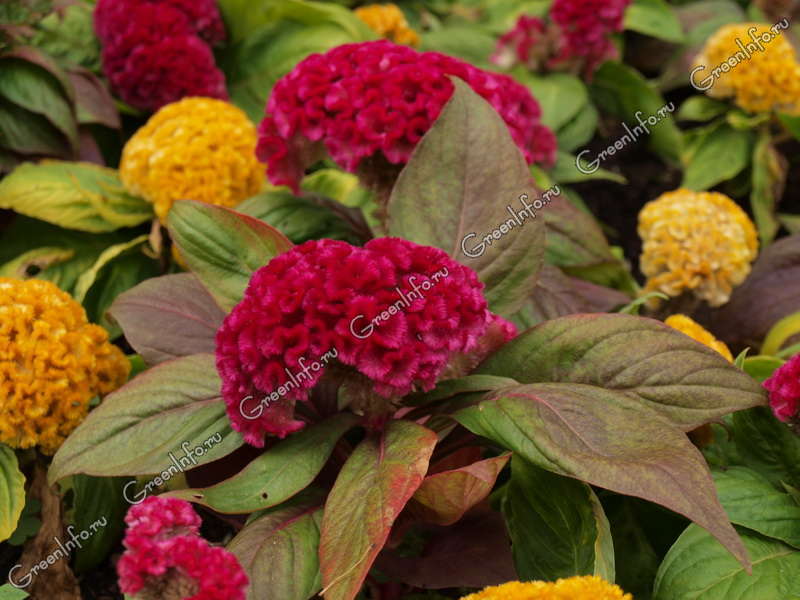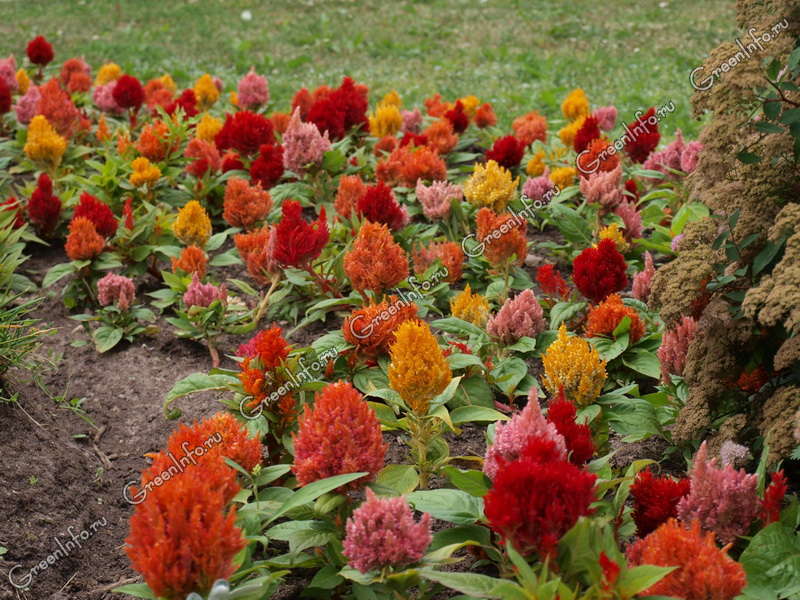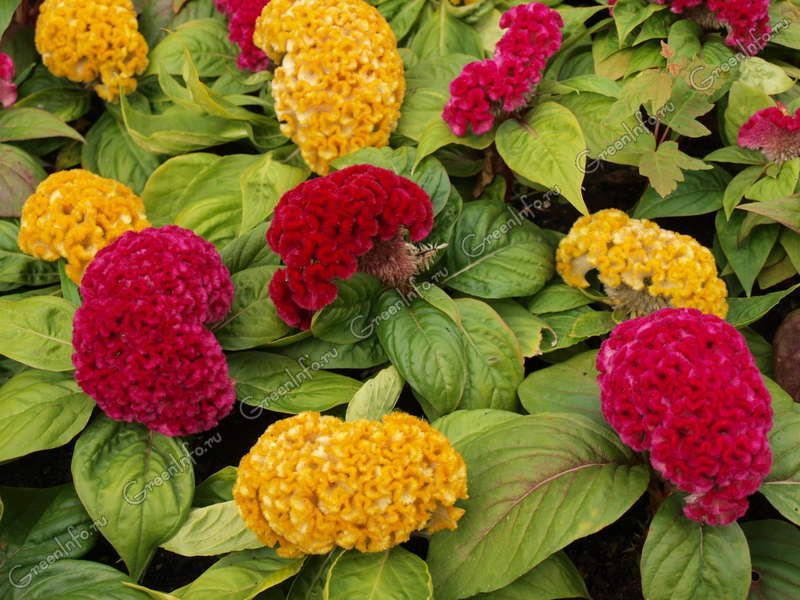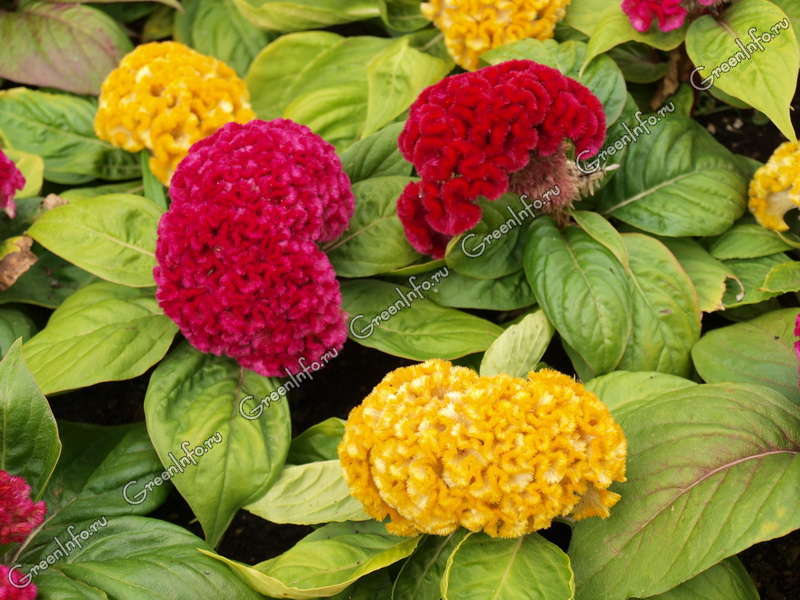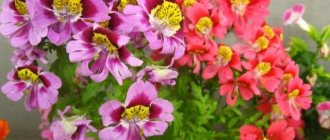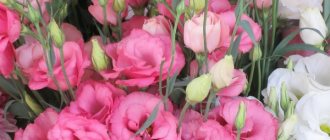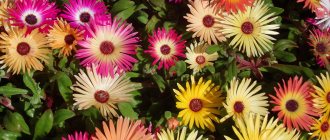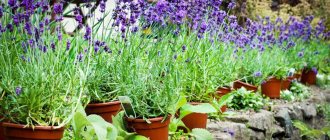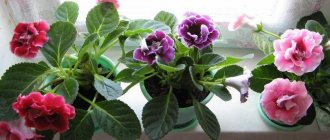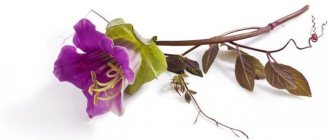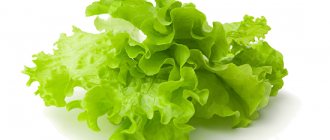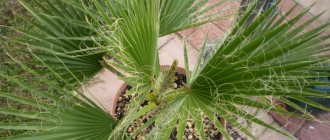The name of celosia comes from the Greek word kelos ("burning", "flaming"), which is explained by the bright color and shape of the inflorescences, similar to tongues of flame. Velvety exotic inflorescences of a variety of celosia look great in the most exquisite flower arrangements, coloring our gardens. Amazingly beautiful undersized potted celosia are an elegant decoration of the sunny loggia and balcony.
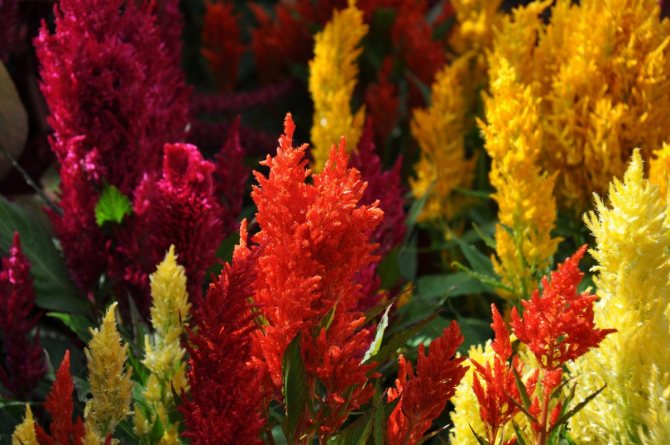
Silver celosia (lat.Celosia argentea).
Features and description of cellosis
Celosia is a perennial or annual plant that belongs to the Amaranth family. Although there are perennial varieties and even shrubs, it is possible to grow celosia as an annual plant on the territory of Russia under the conditions of our climate - it does not withstand low temperatures. The natural habitat of celosia is considered to be the territory of warm continents - North and South America, Asia, Africa. It was here that the first varieties of this culture appeared, which were later adopted by European breeders as the basis for breeding new species and varieties of cellosia.
The common name for celosia comes from the Greek word "kelos", which in translation means "flaming, burning, fiery." This is due to the appearance of the plant, the inflorescences of which resemble real tongues of flame, especially in varieties with red flowers.
The celosia plant can be grown as a room crop, this applies mainly to comb celosia. Tall varieties of culture look great when cut, they can be used to form bouquets.
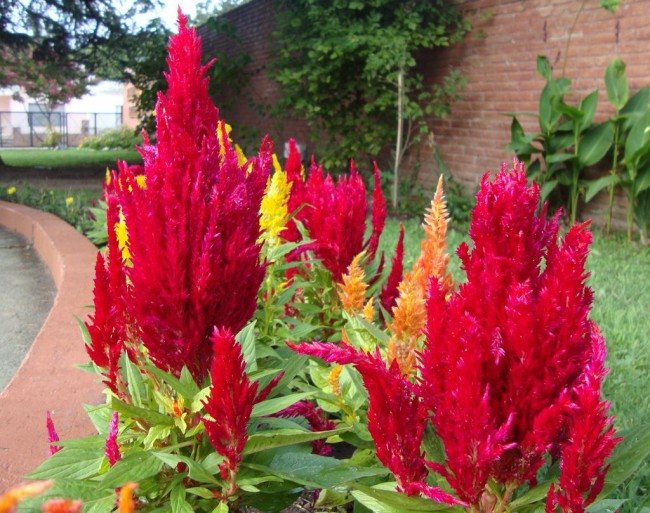

Description of cellosis:
- Celosia is a perennial or annual herb that is grown as an annual in temperate climates.
- There are also shrub forms of celosia.
- Celosia has a well-developed root system, which is represented by a taproot and a large number of lateral roots, which together reach a length of 20-25 cm.
- The stem of the plant is erect and branched, in height it can reach about 30-100 cm. The color of the stem is a rich green hue, often with a reddish tint.
- Leaves all over the stem are arranged in a regular order. They are solid and smooth ovoid leaf plates with a pointed end. The foliage can be green, variegated and dark purple in color.
- Flowers in celosia are small, bisexual, collected in spike-shaped, paniculate and scallop inflorescences, depending on the specific type of culture.
- The color of the cellosis during flowering is simply amazing. These are bright yellow, red, pink, red-purple, red-purple, salmon shades, like tongues of flame burning on flower beds.
- After the flowering of the inflorescences, fruits appear on the plant, which are small rounded bolls. These capsules contain cellosia seeds - small, black and shiny. Seeds remain viable for 5 years.
- Celosia does not tolerate low temperatures, so our winters are not suitable for it. But for the winter time, you can dry a beautiful herbarium of bright inflorescences of celosia.
- This plant is widely used in folk medicine.
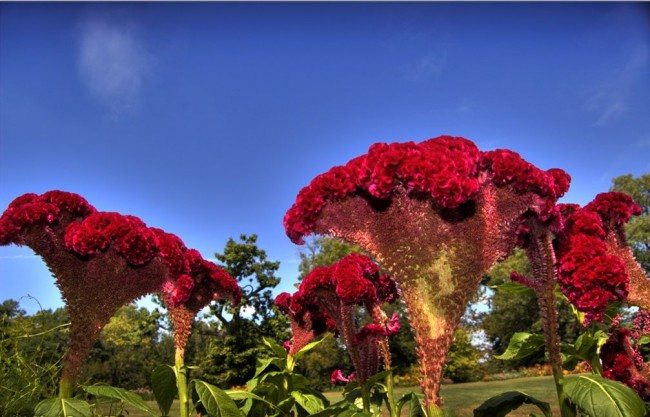

Gallery: silver celosia (25 photos)
Celosia cristate silvery
A flower 20–40 cm high with a comb-like "bud" of red, burgundy, pink, orange, there are other colors. Leaves are smooth green, red or golden, oval in shape with smooth edges. In countries with a harsh winter climate, it is grown as an annual, does not tolerate frost. Scallop celosia is very much appreciated by gardeners, it is considered the queen of the flower bed, its bright inflorescences always attract the attention of people. The flowering period is from early July to late September.
Variety of types and varieties of cellosis
Today there are about 60 varieties of celosia, which differ in the most different characteristics and colors of inflorescences. On the territory of Russia, the most popular are three varieties of this culture, which got their name from the shape of the inflorescences: comb, pinnate, spikelet. Two types are silver celosia. Let's consider in more detail the features of each type.
Celosia comb
- By its nature, it is a perennial plant, but in our territory it is used only as an annual.
- In the people you can often find the name "cockscomb" because of the shape of the inflorescences, which are very similar to a real comb.
- This is a herbaceous plant that can reach a height of 50-65 cm. However, there are also low-growing varieties of this type of cellosia in the culture.
- The stem of the cellosia is comb-like green with a reddish tint.
- The entire stem is densely covered with petiolate, alternate, ovoid leaves.
- Depending on the specific variety, the leaves can be of different colors: green, burgundy, bronze, golden.
- The most real decoration of the crested comb is the original inflorescence, the likes of which are difficult to find in nature.
- Celosia flowers are very small in size, collected in fairly large and massive inflorescences. Several convolutions run along the upper edge of the inflorescences, which makes this flower look like a cock's comb. The diameter of the inflorescence can reach about 15 cm.
- This flower simply amazes the imagination with its bright colors: red, scarlet, orange, purple-red, yellow.
- A flowerbed with a comb-like plant will be an ideal decoration for any area and during flowering will attract the eyes of passers-by.
- Flowering begins around June and lasts until October. Long flowering is a distinctive feature of the culture.


Popular varieties of Celosia comb:
- Celosia variety "Impress". This is the most popular varieties of celosia, which gardeners of central Russia prefer to grow. The plant can reach a height of about 30-40 cm. It is distinguished by bright burgundy scallop inflorescences. The stems are completely covered with dark purple ovoid leaves.
- Celosi grade "Imperialis". It belongs to the dwarf species, which reach a height of only 25 cm. This variety of comb celosia is also very popular among gardeners. The stem of the burgundy plant is completely covered with purple leaves, which are completely covered with veins. At the top of the stem is a bright purple inflorescence.
- Celosia variety "Atropurpurea". It is also a dwarf variety, which can reach a height of about 25-30 cm. The stem of the variety is green-pink, at the top of which is a beautiful and large purple-red inflorescence. The stem is covered with light green ovoid leaves with pink veins.
- Tall Mixed variety. This is a mixture of comb cellosis. Plants reach a height of about 75 cm. You can get a flower bed with a variety of colors of inflorescences.
- Nana Mixed variety of comb cellosis. A variety of flowers with stems 30-35 cm long. Inflorescences differ in the most different colors.
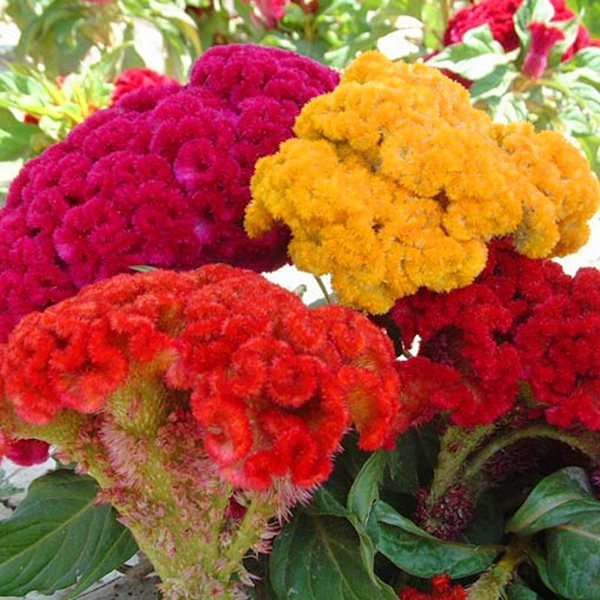

Celosia pinnate
- It is also a form of silvery celosia, called paniculata celosia, and is popular among gardeners.
- The natural habitat of this type of celosia is considered to be the territory of the tropics.
- A fairly tall plant that can reach a height of 30 cm to 100 cm, which is why it can be used in various garden compositions.
- Stems are green, completely covered with light green, pink or scarlet oblong leaves.
- If you plant several flowers of celosia pinnate next to each other, you will get a beautiful small bush, a third of which is a lush inflorescence.
- Small flowers are collected in large inflorescences, which can have a very different color: red, pink, burgundy, orange, yellow.
- Most often, the stores sell variety mixtures of a species with a variety of shades.
- Celosia pinnate differs in the duration of flowering, can delight with bright and beautiful inflorescences until frost.
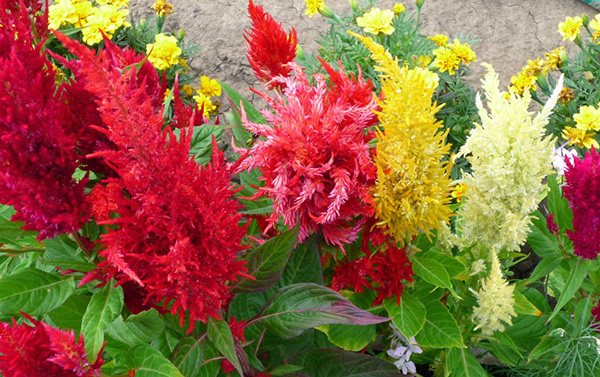

Popular varieties of celosia pinnate:
- Celosi variety "Flamingo Feather". These are medium-sized plants that can reach a height of about 50 cm. They are distinguished by beautiful inflorescences of a soft pink hue, which resemble the color of the plumage of flamingos.
- Variety "Pampas Plum". Also flowers of medium height, growing about 45-50 cm. During flowering, they delight with beautiful yellow and red inflorescences.
- Celosia pinnate variety "Forest Fire". Tall flowers with bright red inflorescences.
- Celosi pinnate variety "Kimono Mixed". It is a mixture of colors of very different shades. They belong to the dwarf variety of this plant - the flowers can reach a height of only 10 cm.
- Grade "Golden Flitz". A beautiful variety of celosia up to 80 cm high. It is distinguished by bright orange-golden inflorescences.
- Feuerfeder pinnate cellosia. A dwarf variety of celosia, the plants of which can reach a height of about 35 cm. They bloom with bright red inflorescences.
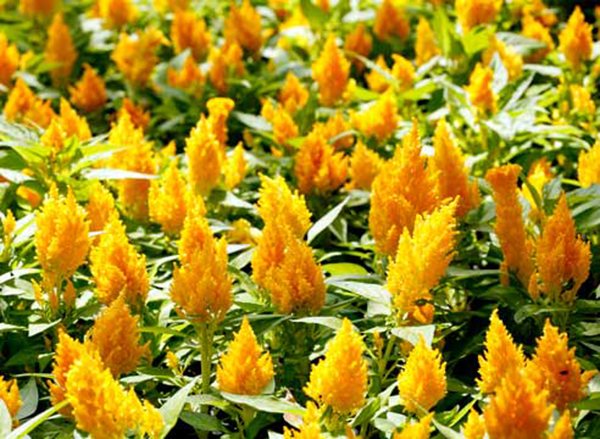

Spikelet celosia
- This type of celosia is less popular among gardeners.
- It is a flower of different heights, which can range from 30 cm to 120 cm.
- The inflorescences of this type of celosia resemble fluffy spikelets of wheat, which can have a very different shade: white, yellow, red, burgundy, purple.
- The dark green stem is completely covered with thin, oblong leaves.
- At the top of the stem is a spike-shaped inflorescence, very fluffy and delicate.
- This type of celosia is famous for its healing properties.


Brief description of the culture
Crested celosia (Celosia argentea f. Cristata), which is also called "cockscomb", is a representative of the Amaranth family, numbering about 60 species. This is a small plant (about 45 centimeters in height, although there are less tall species) with small flowers collected in large inflorescences. The inflorescences themselves, by the way, in their shape resemble an orange or purple rooster's comb, hence the name of the culture. The flowering period begins in mid-summer and ends around October.
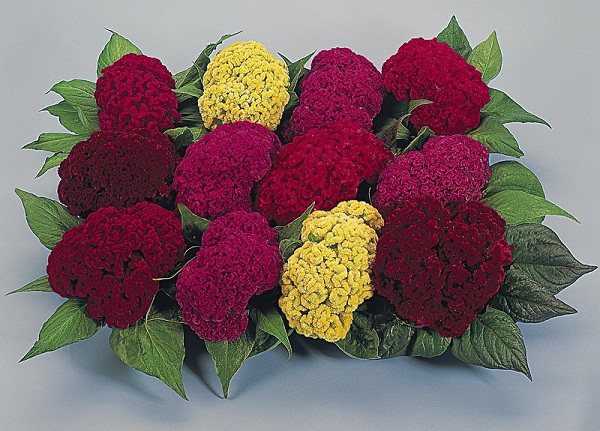

Celosia silvery comb, photo
Medium-sized leaves can be golden, green, bronze or burgundy (it all depends on the specific variety).
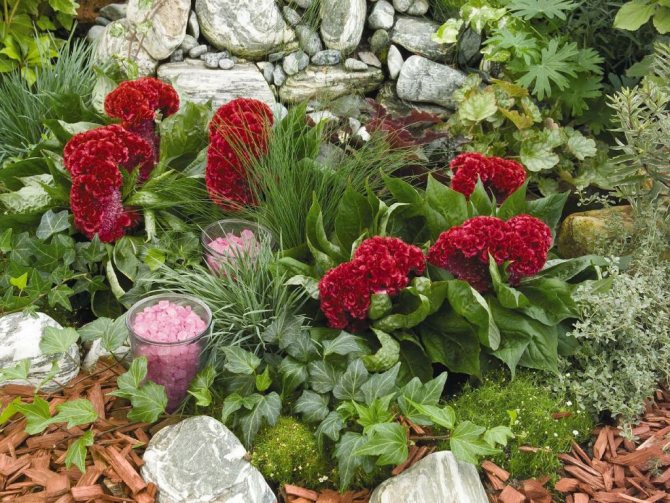

Celosia silvery comb dwarf
Popular varieties of crested comb include:
- Impress (plants with dark green leaves and red flowers, the stem reaches 20-25 centimeters in height);
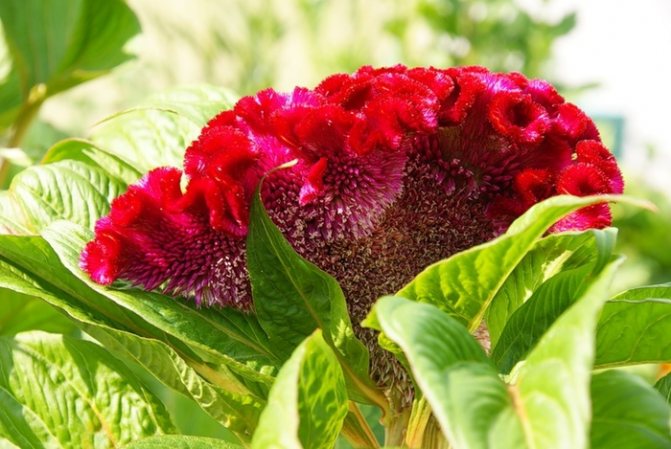

Impress
- Imperialis (miniature variety with purple leaves (red veins visible), red shoots and dark red flowers);
Imperialis - Atropurpurea (the height of representatives of this variety also reaches 20-25 centimeters, the leaves are dark red, the inflorescences are red).
Atropurpurea
Among the entire family of Amaranth florists, it is celosia that is distinguished, mainly due to its unusual shape and color.
The procedure for growing the described culture occurs in stages, we will consider the features of each of the stages in more detail.
Stage one. Choosing a suitable place
For flowers, it is important to choose the right planting site.
So, first, choose the best place. This may be an area sheltered from the wind and sufficiently well illuminated by the sun. The soil should be loose, with a low level of acidity and not very heavy, otherwise the plants will develop poorly and sooner or later die. If there is no black soil on your site, then first add a certain amount of sand to the soil.
Celosia reacts well to humus, so you can add it during preparation or directly during planting. Humus can be applied to any type of soil, since this fertilizer is unable to negatively affect the plant. When the site is selected and properly prepared, you can start planting seeds.
The use of humus will have a beneficial effect on plants.
Stage two. Preparing and sowing seeds
Due to the fact that celosia is extremely tender, it is recommended to pre-grow it as a seedling. If you live in a city, you can use various containers made of any material for this (they will be installed on the windowsill). Here it is imperative to maintain a temperature balance and not allow the soil to overheat / overcool.
Celosia seeds Flower seeds Celosia comb Celosia comb Seeds, seeds in a bag
Immediately before sowing, prepare the seed - keep it in a solution of zircon and epin (add 200 milliliters drop by drop of each of the preparations) for three to four hours - this will help soak the dense seed coat.
Biostimulants "Epin" and "Zircon"
Sow seeds in March-April in the previously made furrows (the distance between the latter should be about 1 centimeter). Do not do it too thickly, after sowing, do not sprinkle the seeds - just press them against the soil and spray with water using a spray bottle.
You can sow flowers in the snow
Note! There is another way of sowing seeds - we are talking about their uniform scattering over the entire area of the previously loosened soil. This method is more convenient, especially since it takes much less time.
After that, cover the containers with glass or plastic and place them on the windowsill, but not in direct sunlight. The room temperature should be 22-25 degrees. Ventilate the room regularly, humidify and remove condensation. By the way, if you don't want to waste time picking in the future, you can plant the seeds in small individual pots.
Seed container covered with cling film
The first shoots should appear in about eight days.
Crop care
Stage three. Picking
When growing seedlings, take care of additional lighting - about five to six hours a day (the fact is that the daylight hours are still short during these months). If the seeds were sown in groups, and not in individual pots, then you will have to pick twice.
Seedlings of celosi
- Carry out the first pick when each plant has two or three true leaves. Transplant the seedlings into the same soil in shallow containers (no more than an inch deep) five centimeters apart. As soon as the seedlings take root, add a solution of min. fertilizers (intended for flowering crops) of a complex type.
- Carry out the second pick when the seedlings are strong enough. Move them into a cassette of greater depth, or, alternatively, carefully remove them together with a lump of earth and place them in individual pots (preferably peat-humus). When the seedlings start, apply the same fertilizing as after the first pick.
Dive seedlings
Stage four. Disembarkation of a comb-like
When the heat is finally established, and the threat of frost at night has passed (as a rule, this is the end of May), you can start transplanting seedlings into open soil.
Step one. If the selected site was not prepared in advance, then start with its preparation. Dig up the earth, then add humus and some sand (if it is heavy), mix everything thoroughly and leave for seven days or more. A couple of days before transplanting, water the area with a weak solution of manganese - this will protect the plants from pests.
Prepare the soil in the flower bed
Note! If the acidity of the soil is increased, then liming it two to three days before transplanting.
In addition, one should not forget that fresh organic matter cannot be introduced into the soil under the cultivation, since the culture simply does not tolerate it.
Step two. After that, proceed directly to the transplant. Young plants are very fragile, so be careful not to damage them in the process. In the selected area, make holes for flowers (the distance between the plants should be about 30 centimeters, 15 will be enough for dwarf varieties).
Planting seedlings in the ground
Step three. Using a special spoon, remove the first plant along with the soil from the container and place in the hole. Distribute the roots carefully. Do the same with the remaining seedlings.
Step three. Fill the holes with your palm, and gradually. Do not tamp the soil too hard, but do not leave the "tubercle" (the latter will interfere with watering).
Compact the soil with your hands around the stem, as shown in the photo.
Note! In case of a high groundwater level on the site, drain the planting site before starting work.
Stage five. Further care
Care is not difficult, the main thing is to know about the weak spots of the culture: a plant in open soil can die even with minimal frost; moreover, it does not tolerate excess moisture. There are a number of important rules that will help you.
Table. Rules for the care of a crested comb
| Procedure | Primary requirements |
| Watering | The ground should not be too wet, but it should not be allowed to dry out either, so abundant watering is not required in this case. Ideally, watering should be done every morning, but if the weather is too hot, it is best to do it in the evening. Otherwise, the root system can be damaged, causing shock to the plant. Water for irrigation must be settled, its temperature must correspond to the ambient temperature. |
| Fertilizer | It should be applied at least once a month, but many experienced growers assure that the development of cellosis is better only when one portion of fertilizer is divided into several. These small portions can be applied weekly to ensure that the required level of minerals in the soil is maintained (that is, this level will not be depleted or exceeded). The optimal feeding concentration is 15 grams per 5 liters of water. |
| Disease protection | The best plant protection is proper watering. If the "black leg", which is often observed in the early stages, nevertheless manifested itself (the lower parts of the stems turned black), then loosen the soil under the plants, sprinkle it with a lot of ash and, more importantly, minimize the amount of water applied during irrigation. |
| Pest control | Also, aphids can settle on celosia, which is usually fought with the following composition: 200 milliliters of vegetable oil and two teaspoons of liquid soap are diluted in two glasses of water. With the help of the resulting product, the plants are processed several times a day (it is preferable to do this in the evening). As for other insects and diseases, the comb celosia is quite resistant to them. |
If you take these simple measures, then a real beauty will decorate your garden! The described plant will become the highlight of any collection and landscape exposition. The main difference between celosia is that it does not require special care, which is extremely convenient for flower growers (especially for beginners).
Celosia comb yellow as a garden decoration
Growing seedlings from seeds - step by step instructions
Celosia in our area is grown as an annual plant, therefore seed reproduction is considered the only way to breed this crop. In warmer countries, propagation of cellosis by cuttings is also possible, but in this case the plant loses its decorative effect. Consider in more detail the process of growing seedlings of cellosia.
- Growing cellosis from seeds is a fairly simple but time-consuming process.
- First of all, you need to purchase planting material. You can buy seeds in specialized garden centers. If a beauty-celosia is already growing on your site, you can wait for the inflorescences to fade. After that, pick one, take a sheet of paper over which you need to shake the inflorescence. The seeds spill out without any problems.
- Celosia seeds are covered with a very dense shell that must be softened in order for them to hatch.
- You need to start preparing planting material around March-April. To do this, take a container and fill it with a solution of epin and zircon (you need 1 drop in a glass of water). Place the seeds in this solution and wait 5-6 hours.
- It must be remembered that the seeds must be immediately placed in the ground from the solution. Therefore, containers with potting soil are prepared in advance.
- To grow seedlings of celosia, it is necessary to mix sand, humus and vermiculite. This potting mix should be placed in suitable containers.
- Seeds are sown on the surface at a distance of about 3 cm from each other. It is not necessary to sprinkle the planting material with soil.
- The soil must be sprayed with a spray bottle and the container must be covered with foil or glass.
- Further care is good lighting, ventilation, watering. You need to air it once a day for about 1-1.5 hours. Watering is best done with a spray bottle in the morning. Try to avoid watering in the evening, as the plant can get sick.
- The first shoots will appear in a week, at this time it is important to provide additional illumination of the seedlings.
- Seedlings dive twice. The first time after the appearance of 2-3 leaves in separate cups or in a large container, the second time cellosia is planted in open ground.
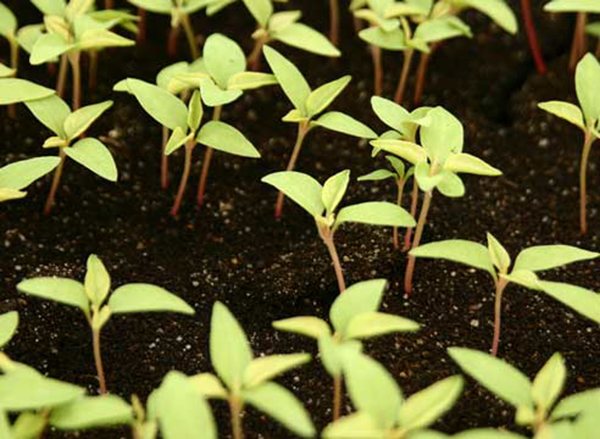

Celosi care
Celosia captivates not only with its beauty, but also with its simplicity of cultivation. Reproduction of cellosis is not difficult. Basically, celosia is propagated by seeds, since during cuttings the decorativeness of plants is sometimes lost.
We advise you to buy seeds of a mixture of varieties, and then the motley cheerful celosi will color your balcony and garden for a very long time - all summer and the warm part of autumn.
Celosia is easy to grow from seed. Sow seeds of cellosis for seedlings in March-April under a film. They are rarely sown on the surface of moist soil. Seedlings dive into pots, since the plant does not tolerate transplanting in open ground. In early June, when the threat of frost has passed, the seedlings are planted in a permanent place.
You can sow cellosis directly into separate pots so as not to damage the root system of plants when picking. The first shoots appear in 4-6 days.
The soil is preferable fertile, loose, structural, non-acidic. It is advisable to choose a place protected from the wind, warm, sunny and without stagnant water. The distance between plants depends on the variety and ranges from 15 cm for low varieties to 30–35 cm for tall ones. Good watering is required during the initial growth period. Top dressing with full mineral fertilizer is done every 10-15 days.If you overfeed plants with nitrogen and organic matter, they will grow powerful, but they will not bloom well.
Celosia seedlings are grown at moderate room temperature (17-20 ° C), with good lighting and ventilation. Preferably on a bright window, protecting from the hot sun. The main thing is moderate and careful watering. It is important not to dry out the soil and not flood young plants, since the roots of cellosia seedlings easily rot from excessively moist soil.
Transplanting grown and acclimatized plants into open ground is carried out only after the end of the spring cold. After all, celosia is very thermophilic and does not tolerate even the slightest frost!
The best place for planting celosia in the garden is sunny, protected from the cold wind. The soil is desirable loose, slightly acidic, well-drained. Celosia is planted in flower beds, in ridges, borders. It grows well in containers, on balconies and window sills. Flowering - from late June to frost.
Fertilizing with mineral fertilizers is carried out once a month. Celosia responds very well to fertilization with lush flowering.
On hot and dry days, abundant watering of the cellosis is necessary, otherwise they lower the leaves and do not form new peduncles.
Note for lovers of dried flowers and winter bouquets: celosia is perfect for floral arrangements!
Celosia inflorescences for a long time perfectly retain their "foppish" shape and model. They do not lose color if cut before seed ripening and dried well in a dark, cool room for two weeks.
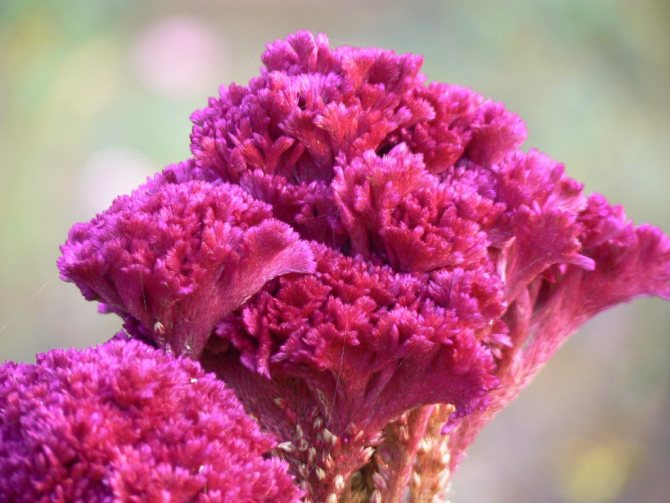

Silver crested celosia (Celosia argentea var.cristata).
Preparatory steps before planting cellosis in open ground
Celosia is a tropical guest who loves warmth and humidity, so it is best to do proper and thorough preparatory work before planting it. It should consist in the selection and purchase of high-quality and healthy planting material, as well as in the selection of the ideal place for planting celosia.
Stage 1. Selection of the variety and planting material of cellosi
- First of all, you need to purchase cellosia planting material, which is perfect for your garden.
- The choice of a particular variety will depend on the garden composition you are planning. Higher varieties of celosia are suitable for the lower edge of the flower bed or for its central part. Dwarf varieties will fit perfectly into the framing of flower beds and flower beds.
- Purchase planting material of zoned varieties that are adapted to the climatic conditions of your area.
- You can purchase seeds and grow seedlings yourself, or you can buy ready-made seedlings of cellosis.
- It is best to buy seedlings in specialized garden centers or nurseries that are professionally engaged in plant breeding. It is here that you can choose the highest quality and most suitable garden material.
- Be sure to check the seedlings before purchasing. It should be kept in pots and look healthy and fresh, free from disease or pests.
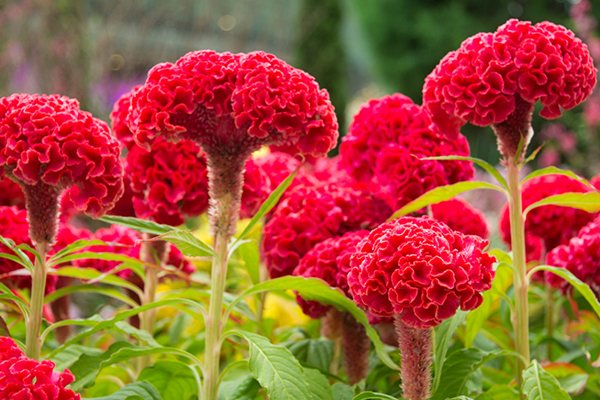

Stage 2. Choosing a place for planting celosi
- Celosia prefers to grow in open, sunny areas.
- The shady spot is not quite suitable for this tropical crop, as this plant will not be able to fully reveal the beauty of its bright inflorescences.
- The site chosen should also be protected from strong winds and drafts, as this can break tall plants.
- The choice of a place for planting will depend primarily on the garden composition you have conceived. Come up with an interesting flower bed and select varieties of celosia for it of different heights.
- The plant does not tolerate stagnant water, so the site should be on a small hill.
Stage 3. Selection and preparation of soil for cellosis
- Celosia prefers to grow on loose and light soils with good drainage.Therefore, before planting in the soil, it is recommended to add some coarse sand or pour a layer of drainage into the bottom of the planting hole.
- It is preferable to select soils with an acid reaction for planting this culture. If your garden doesn't have one, add a little lime to the soil before planting.
- It is not recommended to add organic matter to the soil during preparation, since cellosia does not tolerate this type of fertilizer.
- Before planting, carefully dig up the area you have chosen, loosen it and level it.
Technology of planting seedlings of celosia in open ground
- It is necessary to plant prepared seedlings of celosia in open ground only after the soil and air have completely warmed up.
- First of all, it is necessary to loosen the area for planting and make planting holes on it, the size of which will depend on the size of the earthen coma on the roots of the plant.
- It is important to consider the distance between individual seedlings, which also depends on the cellosi variety. Between dwarf forms, you can retreat about 15 cm, for taller varieties, a distance of 25-35 cm is needed.
- Celosia seedlings have a very delicate and vulnerable root system, so they need to be very carefully transplanted into the ground. In this case, it is best to use the transshipment method.
- A small layer of drainage can be poured at the bottom of each hole to prevent water stagnation at the roots. Gravel, expanded clay or small stones can be used as drainage.
- Place the celosia seedlings in the planting holes and sprinkle gently with potting soil, compacting the soil with your hands.
- After planting, it is recommended to water the young plants.
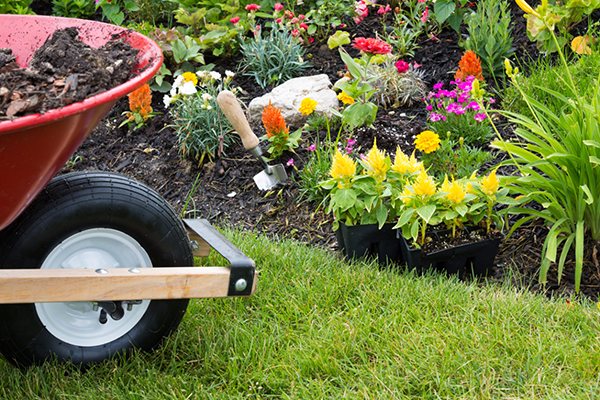

Agrotechnology for growing cellosia: secrets and nuances of care
Caring for the whole plant is minimal, it is for this unpretentiousness that this plant is valued by gardeners. To organize proper care, it is important to know some of the features that are characteristic of this culture: celosia does not like excessively moist soil and even small frosts are afraid of it.
- Watering. Young celosia plants need frequent and abundant watering. Watering is recommended in the morning. Watering frequency increases during drought. However, be careful not to flood the plant. It is necessary to maintain a moist state of the soil, but without stagnation at the roots, which can have a detrimental effect on flowers.
- Loosening. It is recommended to loosen the soil around the plants from time to time after watering. This is necessary to ensure oxygen access to the roots. It is also important to regularly remove weeds that can inhibit the growth and development of cellosis.
- Top dressing. This plant reacts well to fertilizing, which must be carried out every month. It is best to use mineral-based fertilizers, it is not recommended to introduce organic matter, since Celosia loves it.
- Disease and pest control. Very often, at a young age, cellosis is affected by a black leg due to improper watering. If you find this disease, loosen the soil and sprinkle it with charcoal, and stop watering for a while. Sometimes the plant is harmed by aphids, to combat which a solution of liquid soap with sunflower oil is used.
- Celosia - collecting seeds. If you want to enjoy the beauty of cellosis next year, you can collect its seeds yourself. To do this, cut a few flowers and place them in a dry vase. When the flowers are dry, place a sheet of paper on the table and gently shake the inflorescences - the seeds spill out easily.
- Celosia in winter. In our climate, celosia is grown as an annual plant. However, few people know that this plant can be used for floristry. Their bright inflorescences make a very beautiful herbarium, which can be used at home. To dry the herbarium, cut off some pretty flowers, tie them in a bunch and hang them in a dark, well-ventilated area. After a while, you can put the bouquet in a vase.
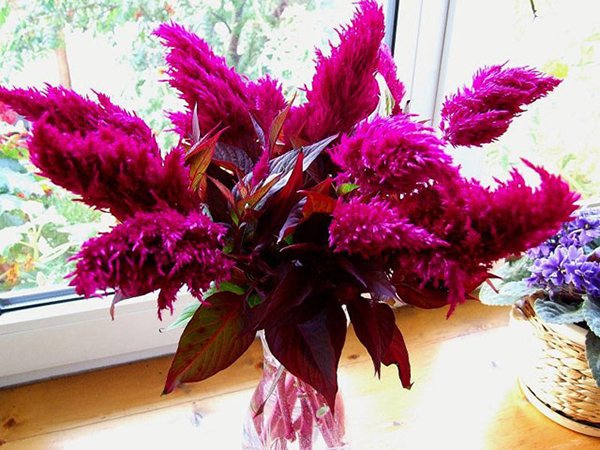

Protection against diseases and pests
Celosia grows quite successfully in the garden and without additional protection from pests and diseases. However, it is still worth taking some measures to prevent the impact of these negative factors.
If we talk about diseases, then these flowers have a fairly high immunity against major pathologies. However, if the irrigation schedule is violated, the crop can still be affected by rot and fungal diseases, therefore, it is impossible to allow waterlogging of the soil or skip loosening.
Aphids can also appear on plants. If you notice these insects, mix 200 ml of vegetable oil with two teaspoons of liquid soap, dilute the resulting mixture in two glasses of water and treat the plants. It is advisable to carry out the procedure in the evening so as not to provoke a leaf burn. Cellosis is quite resistant to other pests and usually there are no problems with its cultivation.
You will find more information about this unusual plant in the video.
The use of celosia in landscape design
Celosia is a very bright and ornamental plant that can be used to create incredible garden compositions. This culture is used with pleasure by gardeners and landscape designers.
- Celosia can be grown in flower beds along with other flowering plants, but it is important to select varieties according to the height and color of the inflorescences.
- This plant looks beautiful in plantings along garden paths or borders.
- Very often you can find celosia in tubs or garden pots, originally arranged around the site.
- Celosia is used to create very unusual garden compositions.
Celosia photo
Tropical celosia flower will be an excellent solution for decorating your site. He will be able to diversify the already familiar views in flower beds and flower beds, add bright fiery colors to the overall palette. In addition, planting and caring for this crop is within the power of even a novice gardener.
How and when to plant
The only breeding method for this crop is seed. As with growing Thyme, before starting planting, you need to familiarize yourself with the following subtleties of cellosis:
- The planting material has a thin shell. And this complicates germination. Before planting, it will have to be soaked by sending it to the epin solution. Keep there for 3-4 hours.
- Sowing seeds for seedlings must be carried out from March to April.
- The soil should be loose.
But what the seeds of the Turkish carnation look like can be seen in the photo in the article.
It will also be interesting to know how to plant Amaranth seeds.
For those who want to know more about how the landing and leaving of Tithonia takes place
maybe

